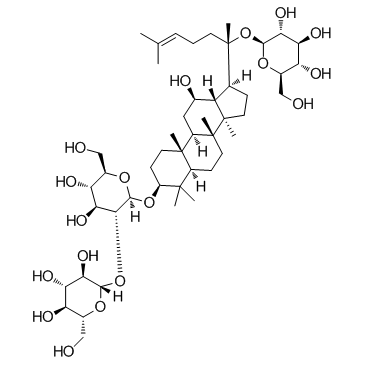Inhibitory effect of ginsenoside-Rd on carrageenan-induced inflammation in rats.
Li Wang, Yunxin Zhang, Zhiping Wang, Sijia Li, Guangning Min, Lihua Wang, Jiajia Chen, Junjun Cheng, Yongjie Wu
文献索引:Can. J. Physiol. Pharmacol. 90(2) , 229-36, (2012)
全文:HTML全文
摘要
A previous study reported that ginsenoside-Rd reduced the production of tumor necrosis factor-α by inhibiting nuclear factor-κB in lipopolysaccharide-activated N9 microglia in vitro. The aim of the present study was to confirm the anti-inflammatory effects and mechanisms of ginsenoside-Rd in animal experiments involving acute inflammation. The results indicated that ginsenoside-Rd at doses ranging from 12.5 to 50 mg/kg i.m. significantly inhibited the swelling of hind paws in rats for 1-6 h after the carrageenan injection. The levels of proinflammatory cytokines and proinflammatory mediators were markedly reduced by ginsenoside-Rd. Ginsenoside-Rd, when administered intramuscularly at 12.5, 25, and 50 mg/kg doses, showed signicant inhibition of carrageenan-induced production of interleukin-1β (6.91%, 45.75%, and 55.18%, respectively), tumor necrosis factor-α (37.99%, 56.39%, and 47.38%, respectively), prostaglandin E(2) (22.92%, 30.12%, and 36.36%, respectively), and nitric oxide (28.27%, 44.53%, and 53.42%, respectively). In addition, ginsenoside-Rd (12.5, 25, and 50 mg/kg i.m.) effectively decreased the levels of nuclear factor-κB (6.77%, 20.28%, and 41.03%, respectively) and phosphorylation of IκBα (13.23%, 26.92%, and 41.80%, respectively) in the carrageenan-inflamed paw tissues. These results suggest that ginsenoside-Rd has significant anti-inflammatory effects in vivo, which might be due to its blocking of the nuclear factor-κB signaling pathway. Thus, it may be possible to develop ginsenoside-Rd as a useful agent for inflammatory diseases.
相关化合物
| 结构式 | 名称/CAS号 | 分子式 | 全部文献 |
|---|---|---|---|
 |
人参皂苷Rd
CAS:52705-93-8 |
C48H82O18 |
|
Transcriptome analysis of Panax vietnamensis var. fuscidicus...
2015-01-01 [BMC Genomics 16 , 159, (2015)] |
|
Protective effects of ginsenoside Rd on PC12 cells against h...
2008-10-01 [Biol. Pharm. Bull. 31(10) , 1923-7, (2008)] |
|
Bioconversion of ginsenoside Rc into Rd by a novel α-L-arabi...
2013-04-01 [Antonie van Leeuwenhoek 103(4) , 747-54, (2013)] |
|
Ginsenoside Rd attenuates early oxidative damage and sequent...
2011-02-01 [Neurochem. Int. 58(3) , 391-8, (2011)] |
|
Highly selective microbial transformation of major ginsenosi...
2012-10-01 [J. Appl. Microbiol. 113(4) , 807-14, (2012)] |